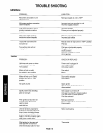
Little attention is needed, but if spillage should occur, it may be necessary to clean around pilot areas, air mixer and
under burners. Use a wire brush if necessary.
Periodically, burners (particularly open top type) should be removed and cleaned. Allow interior to completely drain.
Dry thoroughly before replacing.
HOT TOPS:
Allow range to cool. If water is used on tops while still hot, they may crack. Avoid this practice. Remove tops from
range and clean surfaces with hot water and detergent. A wire brush may be used on the underside of the Hot Top
plate. It is recommended not to clean tops while still on range, even if cooled, as excessive water will drip into the burn-
er box and deteriorate the metal.
Do not waste gas and abuse equipment by leaving all burners “Full On” if not required. During idling periods, adjust
burner valves to keep top warm.
Re-adjust burner valves as required for periods of heavy loads.
CARE OF GRIDDLES:
New griddles should be carefully tempered and cared for in order to avoid possible damage. To break in a new griddle,
first wipe it clean. Next, light all the griddle burners and turn them low for one hour. Then, gradually bring griddle to fry-
ing temperature. Next, spread three or four ounces of beef suet, or as a substitute, baking soda, to season it. Never
allow water on a hot griddle and never wash it with soap and water.
Use a Norton Alundum Griddle Brick to clean griddle. Always remember to heat griddle slowly because quick heat may
cause costly damage. Griddle plates cannot be guaranteed against damage due to carelessness. Never place utensils
on griddle. Do not heat griddle above 55O”F, as this can cause warpage or breakage.
Do not use any type of steel wool. Small particles may be left on the surface and get into food products. Do not clean
spatula by hitting the edge on the griddle plate. Such action will only cut and pit the griddle plate, leaving it rough and
hard to clean.
Do not waste gas or abuse equipment by leaving valves at “Full On” position or thermostat at a high temperature if not
required. During idle periods, set valves at “Low” position or thermostat to low temperature settings to keep griddle
warm. Reset valves or thermostats, as required, for periods of heavy load. Turn valves or thermostats to “off” at end of
daily operation.
OVEN INTERIOR:
A WARNING
For your safety, disconnect the power supply to the appliance before cleaning.
Oven bottom and oven door lining are finished with a porcelain enamel coating which encourages frequent cleaning.
“Spill-avers” should be cleaned from the oven bottom and the door lining a soon as possible to prevent carbonizing and
“burnt-on” condition. Usually, a soap or detergent solution is strong enough. For stubborn accumulations, commercial
oven cleaners are recommended.
The side, rear and top linings have an aluminized coating and should be cleaned with a sponge or cloth and a mild
detergent. Do not use a strong commercial cleaner or abrasive pad, as they may damage the finish.
The rack slides are readily removable for ease in cleaning. To remove, raise them and they will become disengaged
from their hanger studs. After cleaning, reverse procedure to reinstalE5 0 TD 3 Tr279.7704Tr21.840 TD 3 Tr -0.0086 Tc 007840 Tw Fo(regne ) Tj0 Tr 375774 0 TD 3 Tr -0.06 Tc 00.910 Tw matfter


















